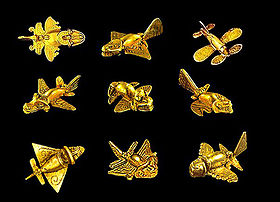Quimbaya artifacts: Difference between revisions
No edit summary |
No edit summary |
||
| Line 1: | Line 1: | ||
[[File:4e2f7c_212adb41475a4aa9ae355dd0e85e264b.jpg]] | [[File:4e2f7c_212adb41475a4aa9ae355dd0e85e264b.jpg]] | ||
== Background == | == Background == | ||
The Quimbaya artifacts can be considered the most valuable and controversial pre-Colombian archaeological discovery. The gold assemblage dates to around 1000 C.E. due to the emergence of gold work appearing in the Quimbaya civilization.<ref>Scott, D.A. & Meyers, P. (1992) ''Archaeometry of Pre-Columbian Sites and Artifacts.'' UCLA institute of archaeology and the Getty conservation institute, Los Angeles California.</ref>The Quimbaya populations occupied parts of Colombia, specifically Eje Cafetero and Valle del Cauca, as early as 100BC. The Quimbaya treasures are most commonly known due to their resemblance to aircrafts. Many theorize that their origin may be of extra-terrestrials. The assemblage is now on display at Museo de América in Madrid. | The Quimbaya artifacts can be considered the most valuable and controversial pre-Colombian archaeological discovery. According to archaeologists, the artifacts measure about 2 to 5 inches tall and represent a variety of birds, insects, lizards, and other animals. The gold assemblage dates to around 1000 C.E. due to the emergence of gold work appearing in the Quimbaya civilization.<ref>Scott, D.A. & Meyers, P. (1992) ''Archaeometry of Pre-Columbian Sites and Artifacts.'' UCLA institute of archaeology and the Getty conservation institute, Los Angeles California.</ref> The Quimbaya populations occupied parts of Colombia, specifically Eje Cafetero and Valle del Cauca, as early as 100BC. The Quimbaya treasures are most commonly known due to their resemblance to aircrafts. Many theorize that their origin may be of extra-terrestrials. The assemblage is now on display at Museo de América in Madrid. | ||
===Discovery=== | ===Discovery=== | ||
The Quimbaya gold figurines were found in two tombs in Cauca river valley of Colombia. The area was looted for gold and other valuable resources in the 16th century, so many contextual artifacts that may have lied with the treasures may never be found. According to reports, there was supposedly 200 gold figurines found when the tombs were looted, but only 123 artifacts were accounted for when ownership was given to Carlos Holguín, President of the Republic, in 1891.<ref>Perea, A, et al. Pre-hispanic goldwork technology. The Quimbaya Treasure, Colombia. Vol. 40, Journal of Archaeological Science, 2013, pp. 2326-34. ScienceDirect.</ref> | The Quimbaya gold figurines were found in two tombs in Cauca river valley of Colombia. The area was looted for gold and other valuable resources in the 16th century, so many contextual artifacts that may have lied with the treasures may never be found. According to reports, there was supposedly 200 gold figurines found when the tombs were looted, but only 123 artifacts were accounted for when ownership was given to Carlos Holguín, President of the Republic, in 1891.<ref>Perea, A, et al. Pre-hispanic goldwork technology. The Quimbaya Treasure, Colombia. Vol. 40, Journal of Archaeological Science, 2013, pp. 2326-34. ScienceDirect.</ref> | ||
Revision as of 02:44, 22 November 2019
Background
The Quimbaya artifacts can be considered the most valuable and controversial pre-Colombian archaeological discovery. According to archaeologists, the artifacts measure about 2 to 5 inches tall and represent a variety of birds, insects, lizards, and other animals. The gold assemblage dates to around 1000 C.E. due to the emergence of gold work appearing in the Quimbaya civilization.[1] The Quimbaya populations occupied parts of Colombia, specifically Eje Cafetero and Valle del Cauca, as early as 100BC. The Quimbaya treasures are most commonly known due to their resemblance to aircrafts. Many theorize that their origin may be of extra-terrestrials. The assemblage is now on display at Museo de América in Madrid.
Discovery
The Quimbaya gold figurines were found in two tombs in Cauca river valley of Colombia. The area was looted for gold and other valuable resources in the 16th century, so many contextual artifacts that may have lied with the treasures may never be found. According to reports, there was supposedly 200 gold figurines found when the tombs were looted, but only 123 artifacts were accounted for when ownership was given to Carlos Holguín, President of the Republic, in 1891.[2]
Context
Pseudoarchaeological Narrative
Theories
Archaeological Record
References
- ↑ Scott, D.A. & Meyers, P. (1992) Archaeometry of Pre-Columbian Sites and Artifacts. UCLA institute of archaeology and the Getty conservation institute, Los Angeles California.
- ↑ Perea, A, et al. Pre-hispanic goldwork technology. The Quimbaya Treasure, Colombia. Vol. 40, Journal of Archaeological Science, 2013, pp. 2326-34. ScienceDirect.
